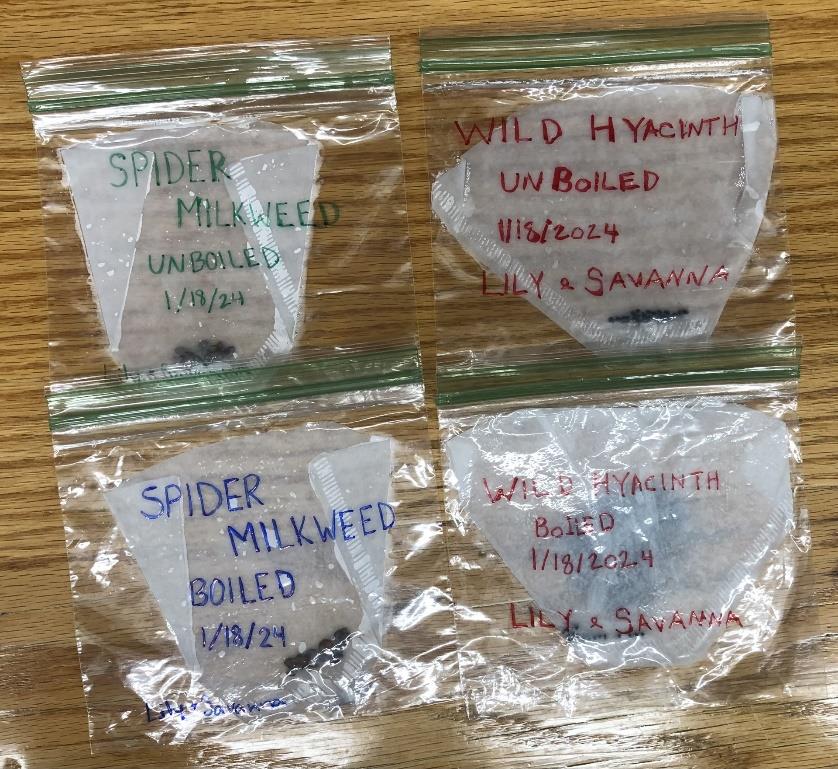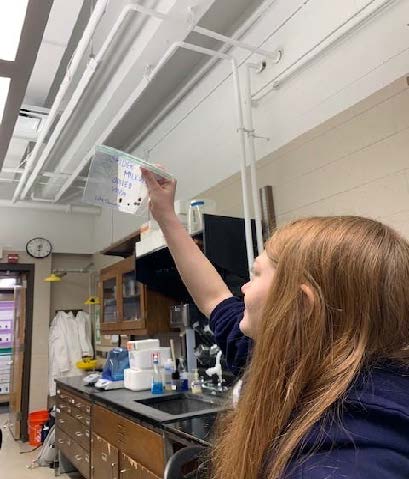February 13, 2024
By Lily Flaherty and Savanna Newkirk
We began the semester by designing and conducting our seed germination experiment. To begin the experiment, we chose two seed packets out of a selection of native Minnesotan plants. The seeds we chose were that of the spider milkweed (Asclepias viridis), which has a germ code of C30 and the wild hyacinth (Camassia scilloides), which has a germ code of M. Seeds with a germ code of C30 need to germinate in a cold, moist environment for 30 days before being planted, and seeds with a germ code of M are best planted outdoors in the fall.
For our experiment, we followed the steps for germ code B with half the seeds from each packet, 24 seeds for the spider milkweed and 44 seeds for the wild hyacinth. For germ code B, you pour boiling water over the seeds and then leave them to soak in the water for approximately 24 hours. Due to scheduling, we allowed the seeds to soak for two days instead of 24 hours. After letting the seeds soak, we followed the steps of germ code C30 for all of the seeds, placing the seed groupings, one group of the germ code B treated seeds and one untreated from each plant, into a coffee filter and dampening it with distilled water before placing it in a sealed plastic bag and allowing them to germinate in the refrigerator. Our hypothesis was that the boiling water would negatively impact the seeds of the spider milkweed, while the wild hyacinth would benefit from the treatment.
We checked every week for any changes to the seed groupings, as well as changing the coffee filters as needed to prevent mold growth. However, no changes have been noticed thus far.

Figure 1: Seed Germination Groups

Figure 2: Savanna Observing Seed Group
We also had the opportunity to measure stomatal densities and aperture lengths. Stomata are small pores in plant tissue that allow gas exchange to occur, which is necessary for life. Aperture lengths are the lengths of the open pores. By learning about this information, we were able to determine how plants and their stomata characteristics help them survive in their environment.
For our experiment, we chose two species of leafy plants from the greenhouse here at MNSU to measure. The first species we chose was a weeping fig (Ficus benjamina), and the second species was an angelwing jasmine (Jasminum nitidum).
To begin the process, we picked three leaves of each species. We then painted a small strip of clear nail polish onto the leaves. We were careful to avoid large, prominent veins. We tried to avoid the veins so that our samples would have an accurate stomata count, as veins do not contain stomata. After leaving the paint to dry, we took a piece of clear tape and attached it to a small part of the nail polish. We slowly peeled the nail polish off the leaf – carefully so that we did not touch the polish – and placed the polish on a slide. After sticking it to a slide, we secured the sample by using more tape. We were then able to observe the stomata through a light microscope.
Through the microscope, we were able to count the number of stomata that were seen in a given area. We took the averages of all three samples of each leaf and found the densities for both species. For our first species, – Ficus benjamina – the leaves had an average stomatal density of 143.543 stomata per mm² and an average aperture length of 0.03630 mm. For our second species, – Jasminum nitidum – the leaves had an average stomatal density of 276.018 stomata per mm² and an average aperture length of 0.04720 mm. After several other calculations, we determined that the SPI (stomatal pore index) for the Ficus benjamina was 0.18915 mm². We also calculated the SPI for the Jasminum nitidum and obtained a result of 0.61492 mm².

